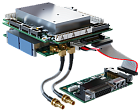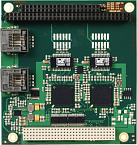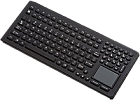 ADLEPC-1500
Mini embedded PC
Based on the ADLE3800SEC Intel E3800-series Atom Edge‑Connect SBC, this compact embedded PC delivers maximum performance in a very small 3.4″ x 3.2″ footprint. It features an Intel E3800-series Atom processor with soldered 4GB or 2GB DDR3 RAM and integrated Intel HD Graphics engine with support for DirectX 11, Open GL 4.0 and full HD video playback.
The ADLEPC-1500 comes packaged in an industrial-grade chassis with mounting options for a variety of environments. Via its SBC edge-connect architecture, it can easily be extended to larger custom systems with added I/O and functionality. This makes possible a fixed processor / software combination across similar products with varying I/O needs.
Applications:
Cyber security edge devices for networks, ICS and SCADA systems, Secure Networking (routing, remote access, traffic monitoring and inspection), EtherCat Master Applications, I/O Gateway, Sensor Data Acquisition, Robotics, Traffic engineering, Kiosk and ATM, Industrial camera systems for toll roads, border security and other applications
ADLEPC-1500
Mini embedded PC
Based on the ADLE3800SEC Intel E3800-series Atom Edge‑Connect SBC, this compact embedded PC delivers maximum performance in a very small 3.4″ x 3.2″ footprint. It features an Intel E3800-series Atom processor with soldered 4GB or 2GB DDR3 RAM and integrated Intel HD Graphics engine with support for DirectX 11, Open GL 4.0 and full HD video playback.
The ADLEPC-1500 comes packaged in an industrial-grade chassis with mounting options for a variety of environments. Via its SBC edge-connect architecture, it can easily be extended to larger custom systems with added I/O and functionality. This makes possible a fixed processor / software combination across similar products with varying I/O needs.
Applications:
Cyber security edge devices for networks, ICS and SCADA systems, Secure Networking (routing, remote access, traffic monitoring and inspection), EtherCat Master Applications, I/O Gateway, Sensor Data Acquisition, Robotics, Traffic engineering, Kiosk and ATM, Industrial camera systems for toll roads, border security and other applications
 ADLVIS-1660
Coaxpress PCIE/104 solution
The ADLVIS-1660 Dual CXP-6 is a rugged, small form factor (SFF) CoaXPress solution intended for military and industrial applications. It’s a two-board small form factor PCIe/104 solution featuring a Quad Intel i7-4700EQ processor with a dual CXP-6 module using the x16 PCIe/104 bus resulting is a stunning 1,250 MB/s effective camera bandwidth.
The ADLVIS-1660 features include small outline coaxial cabling for DIN1.0/2.3 connectors optimized for SFF design. It supports PoCXP, is GENICAM compliant and includes Euresys Memento event logging for efficient application software development. A second CXP-6 module can easily be added to support four 1xCXP-6 cameras or two 2xCXP-6 cameras.
The ADLVIS-1660 targets rugged, small form factor industrial high-performance vision solutions in a host of military and industrial environments. It enables very high-definition applications as well as high-framerate applications in less than ideal environments for security and surveillance, traffic management, science, machine vision and a vast range of next-generation vision products.
Applications: Hyperspectral Imaging, Traffic Surveillance, Security Monitoring and Control, Unmanned Systems — High-Resolution Image/Video Capture, High-Speed Automated Optical Inspection, Very High-Resolution Line-Scan Image Acquisition, Military and Defense ISR, High Frame-Rate Motion Analysis and Recording.
ADLVIS-1660
Coaxpress PCIE/104 solution
The ADLVIS-1660 Dual CXP-6 is a rugged, small form factor (SFF) CoaXPress solution intended for military and industrial applications. It’s a two-board small form factor PCIe/104 solution featuring a Quad Intel i7-4700EQ processor with a dual CXP-6 module using the x16 PCIe/104 bus resulting is a stunning 1,250 MB/s effective camera bandwidth.
The ADLVIS-1660 features include small outline coaxial cabling for DIN1.0/2.3 connectors optimized for SFF design. It supports PoCXP, is GENICAM compliant and includes Euresys Memento event logging for efficient application software development. A second CXP-6 module can easily be added to support four 1xCXP-6 cameras or two 2xCXP-6 cameras.
The ADLVIS-1660 targets rugged, small form factor industrial high-performance vision solutions in a host of military and industrial environments. It enables very high-definition applications as well as high-framerate applications in less than ideal environments for security and surveillance, traffic management, science, machine vision and a vast range of next-generation vision products.
Applications: Hyperspectral Imaging, Traffic Surveillance, Security Monitoring and Control, Unmanned Systems — High-Resolution Image/Video Capture, High-Speed Automated Optical Inspection, Very High-Resolution Line-Scan Image Acquisition, Military and Defense ISR, High Frame-Rate Motion Analysis and Recording.
 ADLMES9200
3- and 5-card rugged chassis systems
The rugged ADLMES9200 IP67 chassis is a successor to ADL’s popular ADLMES8200 IP65 chassis system. Improvements include lower weight, lower cost, quick and reliable IP67 integration for rugged military and industrial applications. Design features for military / defense system include MIL-STD 810 tolerance and MIL-STD 461/704/1275 compliance capability.
The ADLMES9200 is compatible with all ADL’s full range of Intel-based PC/104 and 3.5″ SBC’s which range from low-power ATOM to the latest Intel Core i5/i7 processors. Power supply options include ADL’s range of long-life (MTBF>500,000 hrs) with options for MIL-STD 461/704/1275 compliant filtering.
The uni-body design, with minimal, reliable EMC-compliant gasketing makes for better IP67 Ingress protection as well as assembly. Full design and development services are available for chassis customization, cabling, integration and modeling support.
Applications
Rugged: Ground Vehicles, Mission / Payload Computing, Secure Communications, SWaP-constrained systems for mobile, airborne and vehicle
Rugged Industrial: Oil and Gas, Road Construction and Inspection, Mining, Agriculture
ADLMES9200
3- and 5-card rugged chassis systems
The rugged ADLMES9200 IP67 chassis is a successor to ADL’s popular ADLMES8200 IP65 chassis system. Improvements include lower weight, lower cost, quick and reliable IP67 integration for rugged military and industrial applications. Design features for military / defense system include MIL-STD 810 tolerance and MIL-STD 461/704/1275 compliance capability.
The ADLMES9200 is compatible with all ADL’s full range of Intel-based PC/104 and 3.5″ SBC’s which range from low-power ATOM to the latest Intel Core i5/i7 processors. Power supply options include ADL’s range of long-life (MTBF>500,000 hrs) with options for MIL-STD 461/704/1275 compliant filtering.
The uni-body design, with minimal, reliable EMC-compliant gasketing makes for better IP67 Ingress protection as well as assembly. Full design and development services are available for chassis customization, cabling, integration and modeling support.
Applications
Rugged: Ground Vehicles, Mission / Payload Computing, Secure Communications, SWaP-constrained systems for mobile, airborne and vehicle
Rugged Industrial: Oil and Gas, Road Construction and Inspection, Mining, Agriculture
 ADLLAN
2x PC/104-Plus Ethernet LAN
The Intel 82541ER Gigabit Ethernet Controller provides optimized Gigabit networking for PCI designs. This highly efficient controller, with enhanced power management, consumes less than 1.0W of power at Gigabit speeds. When no signal is detected on the wire, the controller reduces power consumption by «downshifting» to 100Mbps to 10Mbps and then powering down the physical- layer circuitry (PHY).
When a signal is detected, the controller automatically negotiates the connection to Gigabit, if available.
The Intel 82541ER combines Intel’s fifth-generation Gigabit MAC design with fully integrated state-of-the-art PHY technology, which meets or exceeds IEEE 802.3ab specifications for Bit Error Rate performance.
ADLLAN
2x PC/104-Plus Ethernet LAN
The Intel 82541ER Gigabit Ethernet Controller provides optimized Gigabit networking for PCI designs. This highly efficient controller, with enhanced power management, consumes less than 1.0W of power at Gigabit speeds. When no signal is detected on the wire, the controller reduces power consumption by «downshifting» to 100Mbps to 10Mbps and then powering down the physical- layer circuitry (PHY).
When a signal is detected, the controller automatically negotiates the connection to Gigabit, if available.
The Intel 82541ER combines Intel’s fifth-generation Gigabit MAC design with fully integrated state-of-the-art PHY technology, which meets or exceeds IEEE 802.3ab specifications for Bit Error Rate performance.
 DU-5K-TP2
Desktop Keyboard with Touchpad
The DU-5K-TP2 is a NEMA 4X-rated keyboard with an ABS polycarbonate case. It has 116-key functionality, including 24 function keys. The integrated Synaptics touchpad pointing device provides a total solution, featuring left and right-click mouse buttons underneath for additional ease of use. The mounting holes on the back further increase the versatility of the unit.
DU-5K-TP2
Desktop Keyboard with Touchpad
The DU-5K-TP2 is a NEMA 4X-rated keyboard with an ABS polycarbonate case. It has 116-key functionality, including 24 function keys. The integrated Synaptics touchpad pointing device provides a total solution, featuring left and right-click mouse buttons underneath for additional ease of use. The mounting holes on the back further increase the versatility of the unit.
 DT-5K
Keyboard with Integrated HulaPoint II™
The DT-5K combines HulaPoint IITM, an upgraded pointing device that offers improved sensitivity and increased durability, with a 10-key numeric keypad in a ruggedized stainless steel case, providing dual functionality in one compact unit. Its 20 function keys provide user versatility. This keyboard also offers user Windows keys for ease of access to the operating system.
DT-5K
Keyboard with Integrated HulaPoint II™
The DT-5K combines HulaPoint IITM, an upgraded pointing device that offers improved sensitivity and increased durability, with a 10-key numeric keypad in a ruggedized stainless steel case, providing dual functionality in one compact unit. Its 20 function keys provide user versatility. This keyboard also offers user Windows keys for ease of access to the operating system.
 DP-88
Small-Footprint Industrial Keyboard
The DP-88 is a small-footprint keyboard that meets harsh use standards. It has 88 full-size keys with embedded notebook key functions. The DP-88 is a perfect fit for industrial, kiosk or mobile computing needs. The DP-88 has a small footprint and the compact case allows for space saving and mobility, and a secondary legend can be accessed with a number lock key.
DP-88
Small-Footprint Industrial Keyboard
The DP-88 is a small-footprint keyboard that meets harsh use standards. It has 88 full-size keys with embedded notebook key functions. The DP-88 is a perfect fit for industrial, kiosk or mobile computing needs. The DP-88 has a small footprint and the compact case allows for space saving and mobility, and a secondary legend can be accessed with a number lock key.
 PM-TB
Panel Mount Industrial Optical Trackball
The new panel mount PM-TB offers solid-state laser trackball technology in a completely sealed and waterproof enclosure. Featuring NEMA 4X protection, the PM-TB’s 38-mm trackball sits inside polycarbonate housings within stainless steel bezels. The trackball is easily removable for convenient cleaning, while an adjustable tension ring ensures the proper amount of trackball smoothness for any user. In addition, the PM-TB features sealed stainless steel switches, including a programmable button. The PM-TB is ESD-safe and available with the choice of either PS/2 or USB cables.
PM-TB
Panel Mount Industrial Optical Trackball
The new panel mount PM-TB offers solid-state laser trackball technology in a completely sealed and waterproof enclosure. Featuring NEMA 4X protection, the PM-TB’s 38-mm trackball sits inside polycarbonate housings within stainless steel bezels. The trackball is easily removable for convenient cleaning, while an adjustable tension ring ensures the proper amount of trackball smoothness for any user. In addition, the PM-TB features sealed stainless steel switches, including a programmable button. The PM-TB is ESD-safe and available with the choice of either PS/2 or USB cables.
 HP-DT
Industrial HulaPoint II™ Pointing Device
The HulaPoint II™, an upgraded pointing device that offers improved sensitivity and increased durability, combines the functionality of a mouse and the flexibility of a joystick in one convenient, small-footprint package. Housed in a sturdy stainless steel case, it provides pressure-sensitive feedback for positive motion control without requiring vigorous movement. The low-profile design contains no protruding parts that might break and no moving elements to collect dust. With its completely sealed NEMA 4X design, the HulaPoint II™ can withstand spills, washdowns, contaminants and the impacts of an industrial environment.
HP-DT
Industrial HulaPoint II™ Pointing Device
The HulaPoint II™, an upgraded pointing device that offers improved sensitivity and increased durability, combines the functionality of a mouse and the flexibility of a joystick in one convenient, small-footprint package. Housed in a sturdy stainless steel case, it provides pressure-sensitive feedback for positive motion control without requiring vigorous movement. The low-profile design contains no protruding parts that might break and no moving elements to collect dust. With its completely sealed NEMA 4X design, the HulaPoint II™ can withstand spills, washdowns, contaminants and the impacts of an industrial environment.
 Mesa 4I24
72/96 bit parallel I/O cards
The MESA 4I24 series of cards are 96 or 72 bit parallel I/O interfaces implemented on the PC/104 bus.
The 4I24 uses 4 (4I24, 4I24I) or 3 (4I24M) socketed 82C55 PIO chips to give for a total of 96 I/O bits (4I24, 4I24I) or 72 I/O bits (4I24M). 3.3K Pullup resistors are provided on all ports to simplify interfacing to contact closure, opto-isolators, etc.
The 4I24 series includes three models with different I/O connectors. The standard 4I24 uses two 50 pin headers for I/O connections. The 50 pin connectors each have 48 I/O bits, ground, and power. The 4I24I uses four 26 pin headers with ISO standard pinout (24 I/O bits per 26 pin connector, pin 2 = GND, pin 26= 5V). The 4I24M has I/O module rack compatible pinouts with three 50 pin connectors each having 24 I/O bits with interleaved grounds. 5V power on the I/O connectors is fused on the 4I24.
All 4I24 models use the 16 bit stack through type PC/104 bus architecture. Four layer circuit card construction is used to minimize radiated EMI and provide optimum ground and power integrity. All CMOS design keeps power consumption to a minimum.
Mesa 4I24
72/96 bit parallel I/O cards
The MESA 4I24 series of cards are 96 or 72 bit parallel I/O interfaces implemented on the PC/104 bus.
The 4I24 uses 4 (4I24, 4I24I) or 3 (4I24M) socketed 82C55 PIO chips to give for a total of 96 I/O bits (4I24, 4I24I) or 72 I/O bits (4I24M). 3.3K Pullup resistors are provided on all ports to simplify interfacing to contact closure, opto-isolators, etc.
The 4I24 series includes three models with different I/O connectors. The standard 4I24 uses two 50 pin headers for I/O connections. The 50 pin connectors each have 48 I/O bits, ground, and power. The 4I24I uses four 26 pin headers with ISO standard pinout (24 I/O bits per 26 pin connector, pin 2 = GND, pin 26= 5V). The 4I24M has I/O module rack compatible pinouts with three 50 pin connectors each having 24 I/O bits with interleaved grounds. 5V power on the I/O connectors is fused on the 4I24.
All 4I24 models use the 16 bit stack through type PC/104 bus architecture. Four layer circuit card construction is used to minimize radiated EMI and provide optimum ground and power integrity. All CMOS design keeps power consumption to a minimum.
